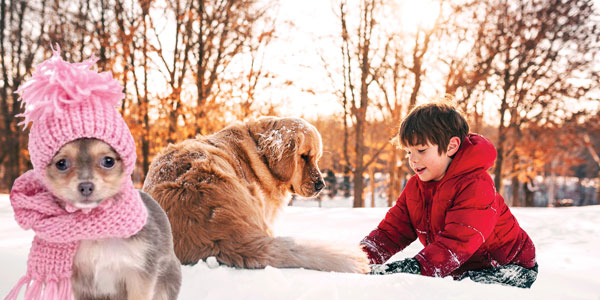
Photo courtesy of Getty Images
(Family Features) When temperatures drop, humans know to bundle up and avoid excess time outdoors. The same approach should be taken when it comes to pets. They may be covered by cozy fur coats, but not all of those coats are created equally.
“Hypothermia is a real danger for pets in the wintertime, and despite pets’ natural fur coats, it doesn’t take long for hypothermia to set in and cause serious problems,” said Jennifer Freeman, DVM, PetSmart’s resident veterinarian and pet care expert.
Freeman recommends keeping an eye out for the initial signs of hypothermia, such as skin that’s cold to the touch, pale skin and gums, intense shivering and lethargy. In addition, she offers these tips to help protect your pet from a blustery winter:
Outdoor access: Limit walks in extreme cold weather and monitor your pet’s behavior for signs of stress or discomfort. Never leave a pet outside during a winter storm. Do not let your dog off its leash after snowfall. Snow masks familiar scents and your pet may become lost and disoriented.
Chemical hazards: Snow-melting products like deicers, antifreeze and salt can cause skin irritations and, if ingested, can be fatal. If you live in an area where these products are used, it’s important to thoroughly rinse your pet’s paws and belly after a walk.
Adding extra layers: If your pet is small and short-haired, he or she is likely sensitive to the cold. The same goes for older pets and those that may be frail or ill. You can’t take your pet’s temperature by touching its nose, but a shivering body means he or she needs a sweater. Larger and long-haired pets can usually tolerate cold weather for longer periods of time, and even though you might bundle up, your pet has a long, thick coat prepared for long winter walks. Just remember paws get cold and sharp objects may be hiding under the powder – consider putting booties on your pet’s paws for added comfort.
Continue in the next edition
_______________________________________________________________________________________________
Ayude a las mascotas a protegerse de los riesgos del invierno- Parte 1
Cuando las temperaturas bajan, los humanos saben abrigarse adecuadamente y evitar pasar mucho tiempo al aire libre. El mismo enfoque se debe tomar cuando se trata de mascotas. Pueden estar cubiertos por abrigos de piel acogedores, pero no todos esos abrigos son creados igualmente.
“La hipotermia es un peligro real para las mascotas en el invierno, y pese a sus abrigos de piel naturales, la hipotermia no toma mucho tiempo en ocurrir y causar problemas serios”, dijo Jennifer Freeman, DVM, veterinaria residente de PetSmart y experta en cuidado de mascotas.
Freeman recomienda mantenerse atentos a los signos iniciales de hipotermia, como la piel fría al tacto, piel y encías pálidas, temblores intensos y letargo. Además, ofrece estos consejos para ayudarle a proteger a su mascota de un invierno ventoso:
Acceso al exterior: Limite las caminatas en climas extremadamente frío y controle el comportamiento de tu mascota para detectar signos de estrés o incomodidad. Nunca deje a una mascota afuera durante una tormenta de invierno. No deje que su perro se suelte de la correa después de la caída de nieve. La nieve enmascara los olores familiares y su mascota puede perderse y desorientarse.
Peligros químicos: Productos para derretir nieve como anticongelantes y sal pueden causar irritaciones en la piel y, si se ingieren, pueden ser fatales. Si vive en un área donde se usan estos productos, es importante enjuagar bien las patas y la barriga de su mascota después de caminar.
Agregar capas adicionales: Si su mascota es pequeña y de pelo corto, es probable que sea sensible al frío. Lo mismo sucede con mascotas más viejas y aquellas que pueden ser frágiles o enfermas. No puede tomar la temperatura de su mascota tocándole la nariz, pero un cuerpo que tiembla significa que su mascota necesita un suéter. Las mascotas más grandes y de pelo largo generalmente pueden tolerar el clima frío por durante períodos de tiempo más largos, y aunque usted puede abrigarse, su mascota tiene un abrigo largo y grueso preparado para largas caminatas de invierno. Sólo recuerde que las patas se enfrían y los objetos afilados pueden estar escondidos debajo del polvo, considere poner botines en las patas de sus mascotas para mayor comodidad.
Continúa en la proxima edición










